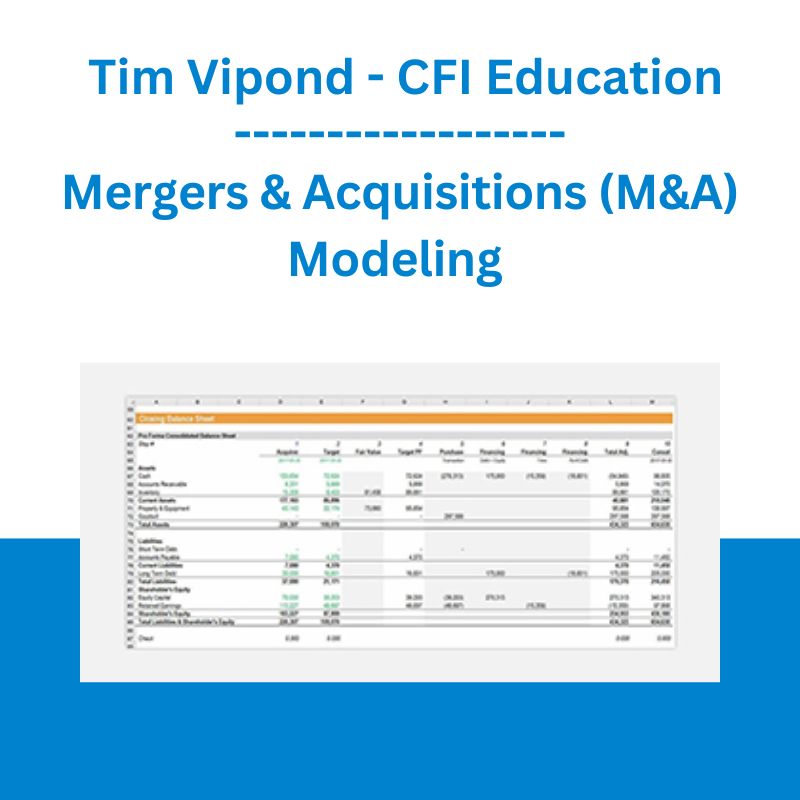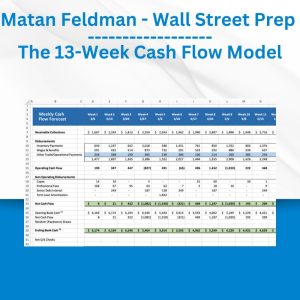*** Proof of Product ***
Exploring the Essential Features of “Mergers & Acquisitions (M&A) Modeling – Tim Vipond – CFI Education”
Learn advanced financial modeling techniques and transaction analysis for mergers and acquisitions (M&A).
- Integrate target companies’ financial statements with the acquirers’, including making the proper transaction-related adjustments
- Evaluate deals by calculating accretion/dilution of earnings per share and cash flow per share
- Value combined entities using DCF models
Overview
Recommended Prep Courses
These preparatory courses are optional, but we recommend you complete the stated prep course(s) or possess the equivalent knowledge prior to enrolling in this course:
- Excel Fundamentals – Formulas for Finance
- 3-Statement Modeling
- DCF Valuation Modeling
Mergers and Acquisitions (M&A) Modeling Course
Welcome to CFI’s advanced financial modeling course on mergers and acquisitions (M&A). This course is designed for professionals working in investment banking, corporate development, private equity, and other areas of corporate finance that deal with analyzing M&A transactions.
M&A Modeling Course Objectives
This advanced financial modeling course has several objectives including:
- Learn how to structure an M&A model in the most efficient way
- Set up all the assumptions and drivers required to build out the M&A model
- Calculate all the necessary adjusting entries required to create a post-transaction balance sheet
- Integrate the acquirer and the target into a pro forma model
- Calculate the accretion or dilution of key per-share metrics post-transaction
- Perform sensitivity analysis on key assumptions and assess the overall impact of the transaction
Who should take this course?
This class is perfect for anyone who wants to learn how to build a financial model for mergers and acquisitions from the bottom up. The video-based lessons will teach you all the formulas and functions to calculate stub periods, outline sources and uses of cash, perform a purchase price allocation and determine goodwill, create multiple scenarios for synergies and other key assumptions, and integrate all of the above into a well laid out pro forma model. In addition to learning the detailed mechanics of how to build the model, students will also learn how to assess the impact of the transaction through accretion/dilution analysis and the impact on the implied share price (intrinsic value per share). By performing sensitivity analysis, users will understand how a change in assumptions impacts future outcomes of the merger or acquisition.
Mergers and Acquisitions Course Case Study
This course is built on a case study of Online Company Inc acquiring Brick ‘n’ Mortar Co. Through the course of the transaction, students will learn about:
- The construction of a detailed Pro Forma model
- Analysis of synergies, revenue enhancements, cost structures
- Integration considerations
- Accretion / dilution analysis
- Deal terms and structuring
- The strategic impact of combining the businesses
- Share price impact
What’s included in this M&A course?
This mergers and acquisitions course includes all of the following:
- Blank M&A model template (Excel)
- Completed M&A model template (Excel)
- 4+ hours of detailed video instruction
What you’ll learn
Introduction to M&A Modeling
Course introduction
Course downloads – M&A model and reference files
Course objectives
Types of advanced financial models
Transaction details
Forms of consideration & synergies
Purchase price allocation and accretion/dilution
M&A case study overview
Interactive exercise 1
M&A Modeling Process
10-step M&A process
M&A templates and resources
Strategic versus financial buyers
M&A model conceptual representation
6-step M&A modeling process
Case study model layout and structure
Case study steps overview
Interactive exercise 2
Acquirer and Target Models
Structure of target and acquirer models
Financial statement mapping
Income statement mapping
Balance sheet mapping
Comparing acquirer and target statements
Creating the transaction stub period
Stub income statement
Stub balance sheet
Stub cash flow
Stub supporting schedules
Interactive exercise 3
Transaction Assumptions
Deal assumptions
M&A transaction inputs
Setting up scenarios
Purchase price
Sources and uses of cash
Shares issued and shares outstanding
Goodwill and purchase price allocation (PPA)
Interactive exercise 4
Closing Balance Sheet
Closing balance sheet introduction
Acquirer and target balance sheets
Fair value adjustments
Other adjustments
Consolidated pro forma balance sheet
Interactive exercise 5
Pro Forma Financial Model
Pro forma model overview
Merger integration revenue
Merger integration expenses
Combined income statement
Combined balance sheet
Changes in working capital
Depreciation schedule
Debt schedule
Target and acquirer debt
Interest schedule
Completing the cash flow statement
Pro forma DCF model setup
Pro forma DCF free cash flow
Pro forma DCF model NPV
Interactive exercise 6
Accretion & Dilution Analysis
Accretion dilution analysis
Earnings per share (EPS) impact
Cash flow per share (CFPS) impact
Testing scenarios
Interactive exercise 7
Sensitivity Analysis & Share Price Impact
Sensitivity analysis overview
Estimating change in intrinsic value per share
Impact on capital structure
M&A sensitivity data tables
Testing sensitivity analysis
Interactive exercise 8
M&A Modeling Conclusion
Download completed M&A model
Review of completed financial model
Summary
Qualified Assessment
Qualified assessment
Please see the full list of alternative group-buy courses available here: https://lunacourse.com/shop/










 TraderSumo - Chart Reading Course
TraderSumo - Chart Reading Course  Team NFT Money - Ultimate NFT Playbook
Team NFT Money - Ultimate NFT Playbook  Ed Ponsi - Forex Trading
Ed Ponsi - Forex Trading  Betsy Polatin & Linda Curran - Touch & Movement in Trauma Therapy - PESI
Betsy Polatin & Linda Curran - Touch & Movement in Trauma Therapy - PESI  Atlas API Training - API 570 Exam Prep Training Course
Atlas API Training - API 570 Exam Prep Training Course  Oliver Velez - Essential Strategy Of Trade For Life
Oliver Velez - Essential Strategy Of Trade For Life  Amber-Lee - Chakra Girl Business School 2022
Amber-Lee - Chakra Girl Business School 2022  Erik Banks - Alternative Risk Transfer
Erik Banks - Alternative Risk Transfer  Emanuele Bonanni - My Trading Way
Emanuele Bonanni - My Trading Way  The Daily Traders – Exclusive Trading Mentorship Group
The Daily Traders – Exclusive Trading Mentorship Group  Fred Haug - Virtual Wholesaling Simplified
Fred Haug - Virtual Wholesaling Simplified  Toshko Raychev - Profit System + ITF Assistant
Toshko Raychev - Profit System + ITF Assistant